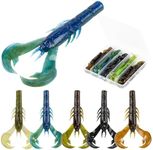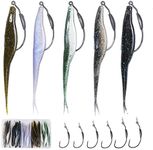Buying Guide for the Best Rubber Worms
When it comes to picking the right rubber worms for fishing, it's important to consider several key specifications to ensure you get the best fit for your needs. Rubber worms come in various shapes, sizes, colors, and materials, each designed to attract different types of fish and perform well in specific fishing conditions. Understanding these specifications will help you make an informed decision and improve your chances of a successful fishing trip.SizeThe size of a rubber worm is crucial because it determines the type of fish you can attract. Rubber worms typically range from 4 to 10 inches in length. Smaller worms (4-6 inches) are ideal for catching smaller fish like bass or panfish, while larger worms (7-10 inches) are better suited for targeting bigger fish such as largemouth bass or pike. Consider the type of fish you are aiming to catch and choose the size accordingly.
ColorColor is an important factor as it can influence the visibility and attractiveness of the worm to fish. Rubber worms come in a wide array of colors, from natural shades like green and brown to bright, flashy colors like pink and chartreuse. In clear water, natural colors that mimic the local baitfish or worms are often more effective. In murky or stained water, brighter colors can help the worm stand out and attract fish. Think about the water conditions where you will be fishing and select a color that will be most visible to the fish.
MaterialThe material of the rubber worm affects its durability and action in the water. Most rubber worms are made from soft plastic, which provides a lifelike movement that can entice fish to bite. Some worms are infused with scents or flavors to make them more appealing. Softer materials tend to have better action but may tear more easily, while tougher materials are more durable but might not move as naturally. Consider how often you fish and the conditions you fish in to decide on the right balance between durability and action.
ShapeThe shape of the rubber worm can influence its action and effectiveness. Common shapes include straight-tail, curly-tail, and ribbon-tail worms. Straight-tail worms have a subtle action and are great for finesse fishing. Curly-tail worms have a more pronounced action that can attract fish from a distance. Ribbon-tail worms combine the features of both, offering a versatile option. Think about the fishing technique you prefer and the behavior of the fish you are targeting to choose the appropriate shape.
BuoyancyBuoyancy determines how the rubber worm behaves in the water. Some worms are designed to float, while others sink or have neutral buoyancy. Floating worms are useful for topwater fishing or when you want the worm to stay above vegetation. Sinking worms are better for bottom fishing or when you need to get the worm down to deeper fish. Neutral buoyancy worms can be used in a variety of situations. Consider the depth at which you will be fishing and the behavior of the fish to select the right buoyancy.




















